Evaluation of Community Commercial Space Design Experience and Optimization Strategy Based on KANO Model
Abstract
:1. Introduction
2. Literature Review
2.1. About Community Commercial Space
2.2. Community Business Research Status
2.3. About the KANO Model Concept
2.4. Relationship between KANO Model and Community Business
3. Research Methodology
3.1. Field Research
3.2. Evaluation Index Construction
3.3. Questionnaire Design
4. Questionnaire Distribution and Analysis of Results
4.1. Questionnaire Reliability and Validity Analysis
4.2. Analysis of the Basic Needs of Community Residents
4.3. KANO Attribute Classification of User Needs
4.4. Prioritization of User Requirements Metrics
4.5. Analysis of Commercial Space Demand of Community Residents
5. Optimization Strategy to Improve the Commercial Space Experience of Community Residents
5.1. Optimization Strategy of Community Business Environment
5.1.1. Optimize the Physical Environment of Commercial Space and Improve the Accessibility of Space
5.1.2. Improve Supporting Facilities to Meet the Basic Needs of Consumers
5.2. Optimization Strategies for Community Business Services
5.2.1. Create Community Services with “Temperature”
5.2.2. Integrate Business Scenarios to Achieve Diversified and Intelligent Development of Business Formats
6. Conclusions
Author Contributions
Funding
Data Availability Statement
Conflicts of Interest
Appendix A
| Pleasure: Quality Service Level | |||||
|---|---|---|---|---|---|
| Forward and Reverse Questions | Enjoyed it | Rightfully so | Doesn’t matter | Reluctantly accepted | Very unlike |
| If this function is available your comment is? | |||||
| If this function is not available your comment is? | |||||
References
- Department of Electronic Commerce and Informatization, Ministry of Commerce of China. China E–Commerce Report 2020; China Commerce Press: Beijing, China, 2020. [Google Scholar]
- Fan, Y. The innovation strategy of physical business marketing model in the context of scene marketing—Wuhan region as an example. China Bus. J. 2022, 11, 27–29. [Google Scholar]
- Yi, X. A study on the system of commercial service facilities in residential areas from the perspective of consumption: The case of Quyang New Village in Shanghai. J. Urban Plan. 2012, 3, 44–52. [Google Scholar]
- Zheng, Y. Research on countermeasures of community business ecology reconstruction under the new consumption trend. Bus. Econ. Res. 2023, 867, 55–58. [Google Scholar]
- Liu, J. Analysis of ten hot spots in the current situation in the field of commerce and circulation economy. Bus. Econ. Res. 2022, 5–7. [Google Scholar]
- Zhao, M. Research on strategies to improve community business service capacity under digital transformation. J. Econ. Res. 2021, 127–129. [Google Scholar]
- Yin, Q. Research on Community Commercial Planning and Design in Large Residential Areas Based on Spatial Syntax. Master’s Thesis, South China University of Technology, Guangzhou, China, 2016. [Google Scholar]
- Ma, J. Measuring the level of development of community commercial wisdom in China and strategies to improve it. Bus. Econ. Res. 2023, 867, 31–34. [Google Scholar]
- Huang, Y. Generation Z “lies flat” community business. China Real Estate 2021, 55–56. [Google Scholar]
- El Hedhli, K. Shopping well–being at the mall: Construct, antecedent and consequences. J. Bus. Res. 2013, 66, 856–863. [Google Scholar] [CrossRef]
- Zorkin, S.; Katsinitz, P.; Chen, X. Local Shopping Streets in Global Cities—Everyday Diversity from New York to Shanghai; Zhang, I., Yang, Z., Eds.; Tongji University Press: Shanghai, China, 2016; p. 9. ISBN 9787560863832. [Google Scholar]
- Mandiberg, J.M.; Warner, R. Business development and marketing within communities of social service clients. J. Bus. Res. 2012, 65, 1736–1742. [Google Scholar] [CrossRef]
- Simma, A.; Axhausen, K. Interactions between Travel Behaviour, Accessibility and Personal Characteristics: The Case of the Upper Austria Region. Eur. J. Transp. Infrastruct. Res. 2003, 3, 179–197. [Google Scholar]
- Wu, D.; Zhou, S. Residential–commercial spatial matching relationship in Guangzhou communities based on daily shopping behavior. Geoscience 2017, 37, 228–235. [Google Scholar]
- Zhou, X. Study on Pedestrian Accessibility Evaluation and Layout Optimization of Community Commercial Facilities. Master’s Thesis, Zhejiang University, Hangzhou, China, 2022. [Google Scholar]
- Chen, J. Analysis of humanistic and emotional design of community commercial space. Huazhong Archit. 2020, 11, 67–70. [Google Scholar]
- Lu, H. Urban community business supply model and policy recommendations. Bus. Econ. Res. 2017, 20, 7. [Google Scholar]
- Ran, L. What the “Beijing” box has brought to the retail industry. Mark. Inf. News 2017, 2. [Google Scholar]
- Song, X.; Wang, G.; Huang, J. A study on the spatial characteristics of experience–based commercial facilities and retail–based commercial facilities in the main urban area of Wuhan based on POI data. Archit. Cult. 2022, 1, 152–154. [Google Scholar]
- Kano, N.; Seraku, N.; Takahashi, F.; Tsuji, S.-I. Attractive quality and must–bequality. J. Jpn. Soc. Qual. Control 1984, 14, 39–48. [Google Scholar]
- Zheng, L.; Wo, C.; Wang, S.; Li, Y.; Mao, Y. Experience design of batik techniques based on KANO model. Silk 2022, 59, 102–108. [Google Scholar]
- Li, D. Introduction to Environmental Behavior; Tsinghua University Press: Beijing, China, 1999. [Google Scholar]
- Abraham, M.; Xu, J. Motivation and Personality; People’s University of China Press: Beijing, China, 2013; pp. 20–25. [Google Scholar]
- Hua, C.; Zhou, X.; Li, Y.; Chang, F. Evaluation of spatial pedestrian accessibility and layout optimization of community commercial facilities––A case study of three districts in Shaoxing city. J. Zhejiang Univ. (Eng. Ed.) 2022, 56, 368–378. [Google Scholar]
- Li, Y.; Liang, Y.; Wang, Y. A study on the mechanism of the dual–path effect of community business ecological configuration on people’s sense of access and happiness. J. Manag. 2022, 19, 1784–1791. [Google Scholar]
- Marcus, C.C.; Francis, C.; Yu, K.; Sun, P.; Wang, Z. Human Places—Guidelines for the Design of Urban Open Spaces, 2nd ed.; China Construction Industry Press: Beijing, China, 2001. [Google Scholar]
- Zhou, J. Research on the influence of urban commercial culture on urban residents’ consumption from the perspective of scene theory. Bus. Econ. Res. 2018, 15, 172–175. [Google Scholar]
- Han, N.; Lai, Y.; Li, F. Standardization of community commerce in China in the digital economy: Practices, problems and countermeasures. Bus. Econ. Res. 2022, 5–8. [Google Scholar]
- Wang, C.; Wang, C. Intelligent transformation of community business in the context of digital economy: Theoretical system and mechanism model. Bus. Econ. Res. 2021, 10, 5–9. [Google Scholar]
- Lin, X.; Mazlan, A.N.; Ismail, S. Barriers to the implementation of value management in small construction projects. J. Build. Eng. 2022, 54, 104639. [Google Scholar] [CrossRef]
- Tian, M.; Song, Y. A comparative study of livable community evaluation indicators. Econ. Syst. Reform 2016, 3, 182–188. [Google Scholar]
- Huang, W.; Hu, L.; Xing, Y. Sustainable renewal strategies for older communities from the perspective of living experience. Sustainability 2022, 14, 2813. [Google Scholar] [CrossRef]
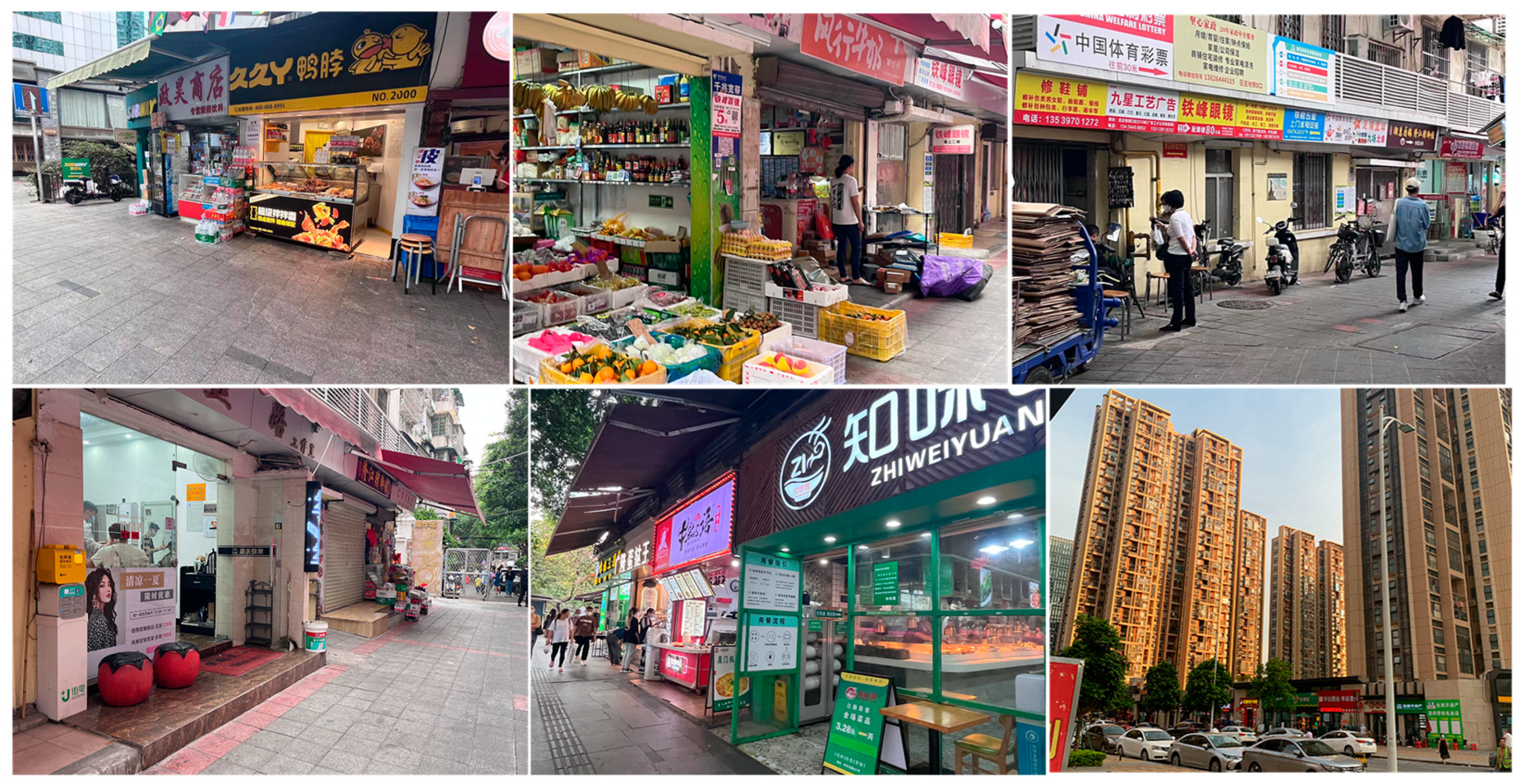
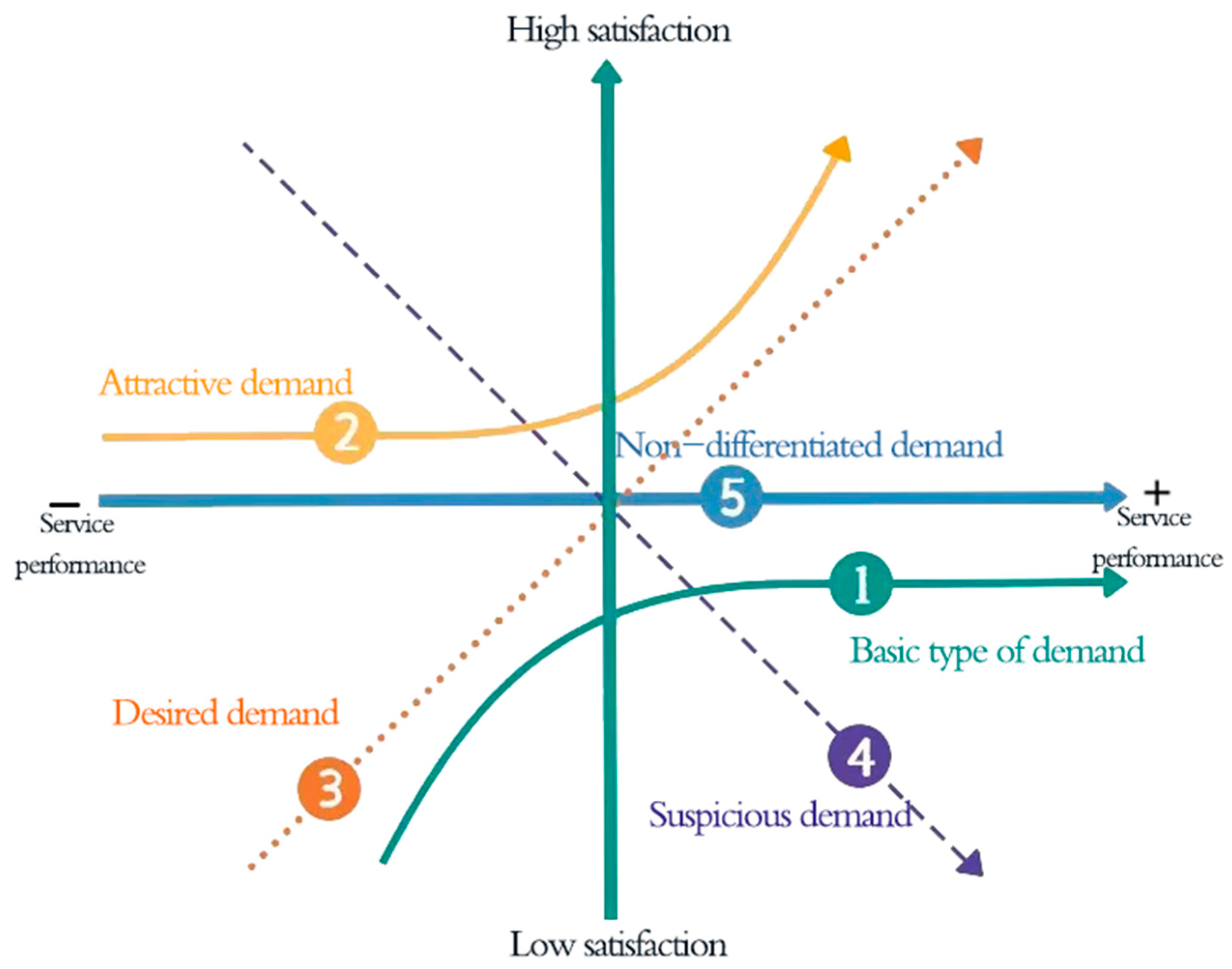
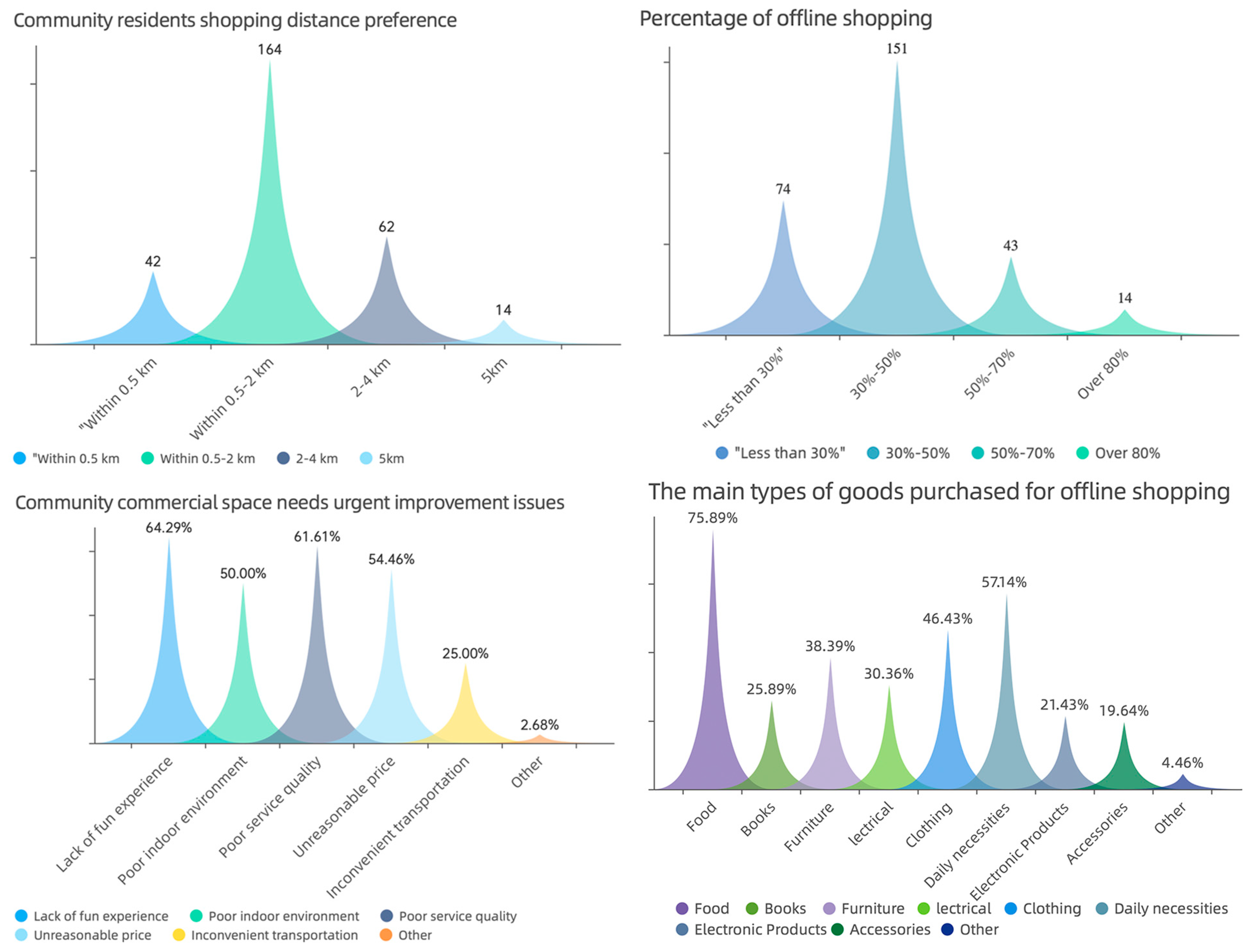
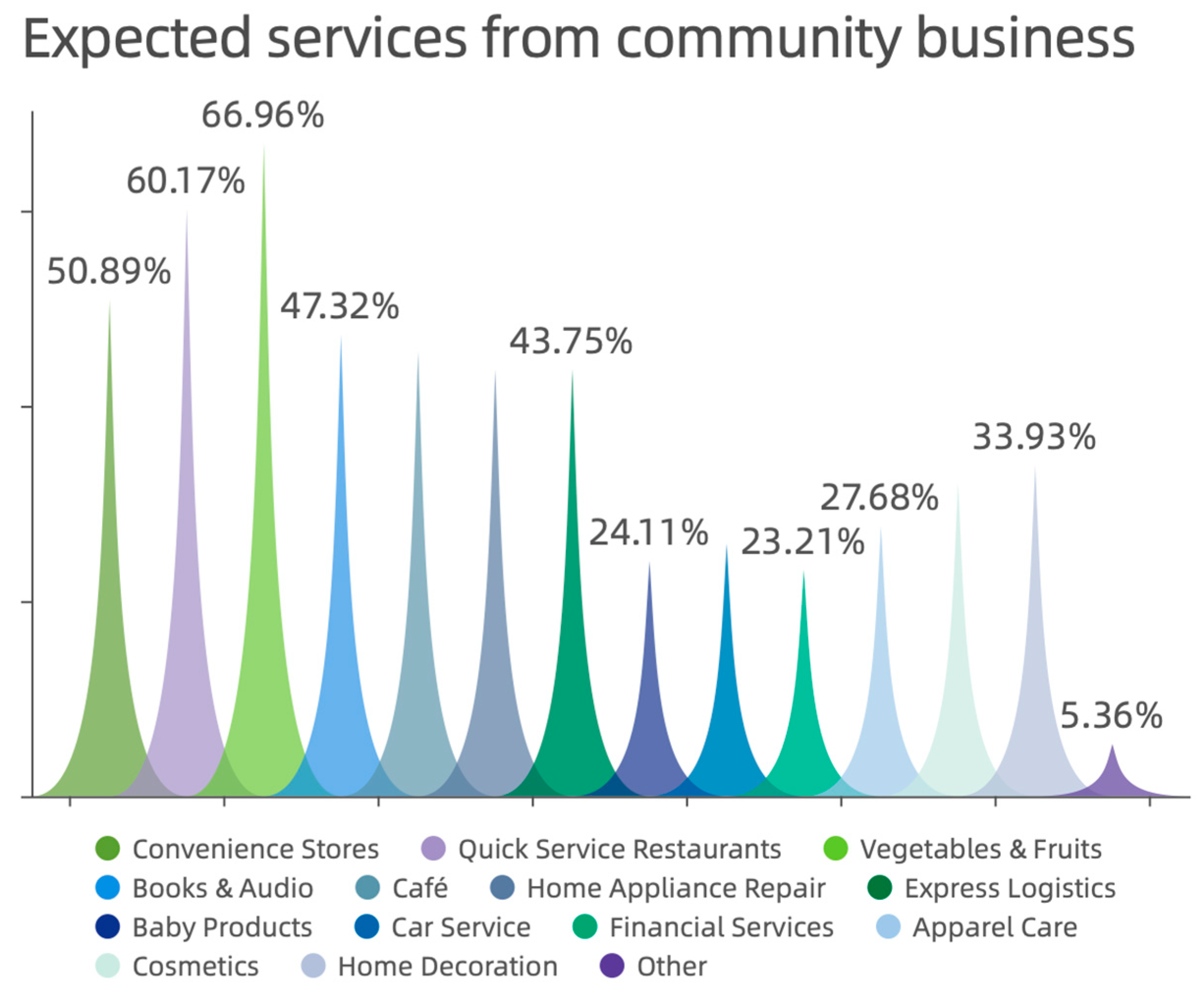
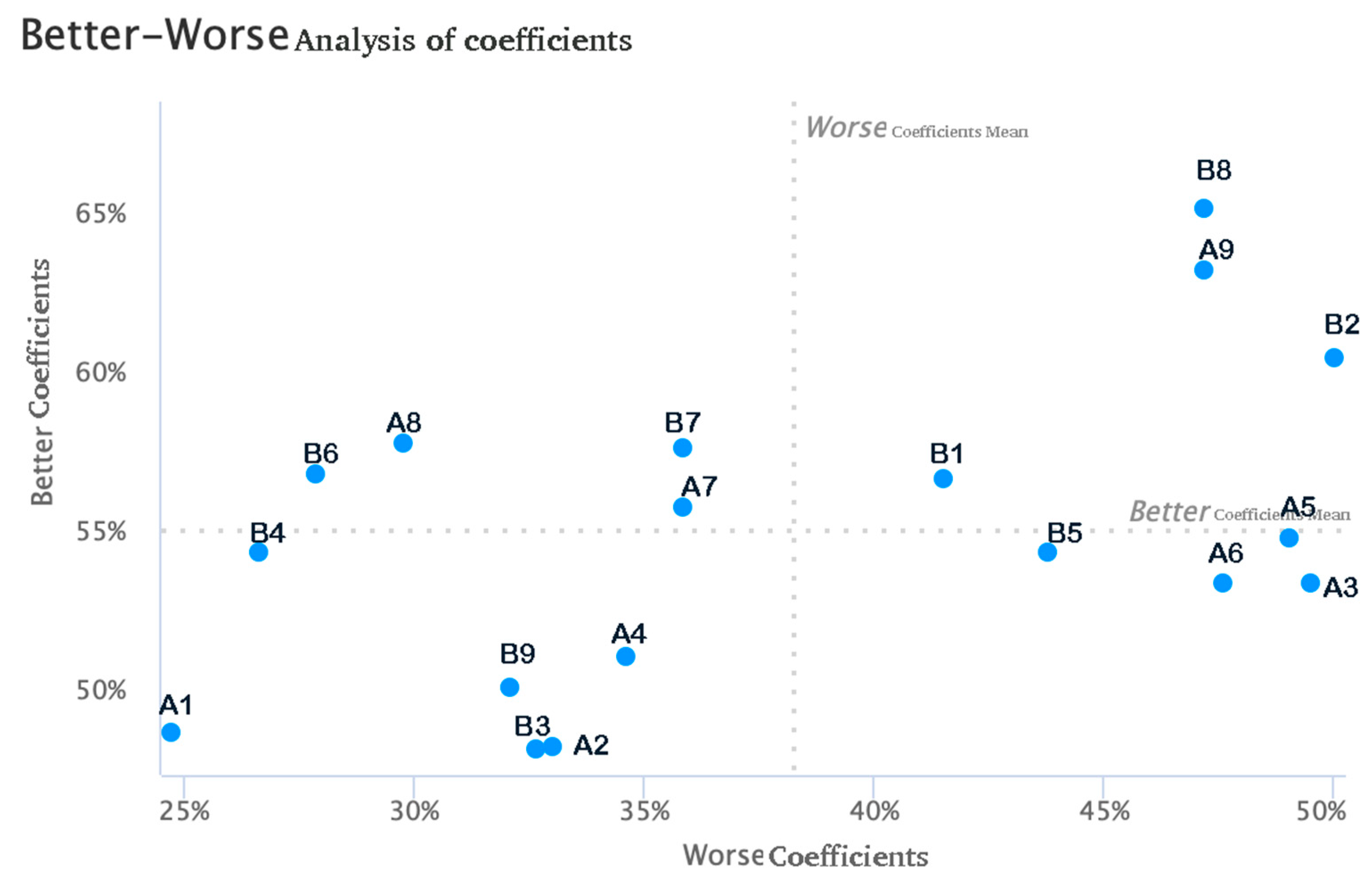
| Functions/Services | Negative Questions | |||||
|---|---|---|---|---|---|---|
| Dislike (1 Point) | Tolerable (2 Point) | Doesn’t Matter (3 Point) | As It Should Be (4 Point) | Like (5 Point) | ||
| Positive Questions | Dislike (1 point) | Q | R | R | R | R |
| Tolerable (2 point) | M | I | I | I | R | |
| Doesn’t matter (3 point) | M | I | I | I | R | |
| As it should be (4 point) | M | I | I | I | R | |
| Like (5 point) | O | A | A | A | Q | |
| Crowd Demand Level | Objective Evaluation | Influencing Factors |
|---|---|---|
| Material demand | Accessibility | Spatial scale |
| Streamline setting | ||
| Transportation convenience | ||
| Security | Barrier-free facilities | |
| Security facilities | ||
| Firefighting facilities | ||
| Convenience | Guidance system | |
| Type of business | ||
| Public facilities | ||
| Spiritual demand | Comfortability | Spatial physical environment |
| Resting space comfort | ||
| Green landscape | ||
| Abundance | Brand awareness | |
| Service type | ||
| Types of leisure activities | ||
| Pleasure | Space culture atmosphere | |
| Service level | ||
| Interactive experience facilities |
| User Demand Indicators | Percentage/% | KANO Properties | Better Factor | Worse Factor | ||||||
|---|---|---|---|---|---|---|---|---|---|---|
| M | O | A | I | R | ||||||
| Material demand | Accessibility | Spatial scale | 0.10 | 0.14 | 0.33 | 0.40 | 0.09 | I | 0.49 | −0.25 |
| Streamline setting | 0.14 | 0.19 | 0.29 | 0.38 | 0.00 | I | 0.48 | −0.33 | ||
| Transportation convenience | 0.17 | 0.32 | 0.21 | 0.29 | 0.00 | O | 0.53 | −0.50 | ||
| Security | Barrier-free facilities | 0.15 | 0.19 | 0.31 | 0.33 | 0.00 | I | 0.51 | −0.35 | |
| Security facilities | 0.21 | 0.28 | 0.26 | 0.25 | 0.00 | O | 0.55 | −0.49 | ||
| Firefighting facilities | 0.17 | 0.30 | 0.23 | 0.29 | 0.00 | O | 0.53 | −0.48 | ||
| Convenience | Guidance system | 0.11 | 0.25 | 0.31 | 0.33 | 0.00 | A | 0.56 | −0.36 | |
| Type of business | 0.10 | 0.19 | 0.38 | 0.31 | 0.00 | A | 0.58 | −0.30 | ||
| Public facilities | 0.15 | 0.32 | 0.31 | 0.22 | 0.00 | O | 0.63 | −0.47 | ||
| Spiritual demand | Comfortability | Spatial physical environment | 0.15 | 0.26 | 0.30 | 0.28 | 0.00 | A | 0.57 | −0.41 |
| Resting space comfort | 0.21 | 0.29 | 0.31 | 0.18 | 0.00 | A | 0.60 | −0.50 | ||
| Green landscape | 0.12 | 0.20 | 0.27 | 0.38 | 0.00 | I | 0.48 | −0.32 | ||
| Abundance | Brand awareness | 0.09 | 0.16 | 0.37 | 0.36 | 0.00 | A | 0.54 | −0.26 | |
| Service type | 0.18 | 0.26 | 0.28 | 0.27 | 0.00 | A | 0.54 | −0.44 | ||
| Types of leisure activities | 0.10 | 0.17 | 0.39 | 0.32 | 0.00 | A | 0.56 | −0.28 | ||
| Pleasure | Space culture atmosphere | 0.10 | 0.25 | 0.32 | 0.31 | 0.00 | A | 0.58 | −0.36 | |
| Service level | 0.10 | 0.36 | 0.28 | 0.24 | 0.00 | O | 0.65 | −0.47 | ||
| Interactive experience facilities | 0.13 | 0.19 | 0.31 | 0.38 | 0.00 | I | 0.50 | −0.32 | ||
Disclaimer/Publisher’s Note: The statements, opinions and data contained in all publications are solely those of the individual author(s) and contributor(s) and not of MDPI and/or the editor(s). MDPI and/or the editor(s) disclaim responsibility for any injury to people or property resulting from any ideas, methods, instructions or products referred to in the content. |
© 2023 by the authors. Licensee MDPI, Basel, Switzerland. This article is an open access article distributed under the terms and conditions of the Creative Commons Attribution (CC BY) license (https://creativecommons.org/licenses/by/4.0/).
Share and Cite
Hu, L.; Fan, J.; Li, C.; Luo, S. Evaluation of Community Commercial Space Design Experience and Optimization Strategy Based on KANO Model. Buildings 2023, 13, 1760. https://doi.org/10.3390/buildings13071760
Hu L, Fan J, Li C, Luo S. Evaluation of Community Commercial Space Design Experience and Optimization Strategy Based on KANO Model. Buildings. 2023; 13(7):1760. https://doi.org/10.3390/buildings13071760
Chicago/Turabian StyleHu, Linhui, Jie Fan, Congcong Li, and Shengjing Luo. 2023. "Evaluation of Community Commercial Space Design Experience and Optimization Strategy Based on KANO Model" Buildings 13, no. 7: 1760. https://doi.org/10.3390/buildings13071760
APA StyleHu, L., Fan, J., Li, C., & Luo, S. (2023). Evaluation of Community Commercial Space Design Experience and Optimization Strategy Based on KANO Model. Buildings, 13(7), 1760. https://doi.org/10.3390/buildings13071760







